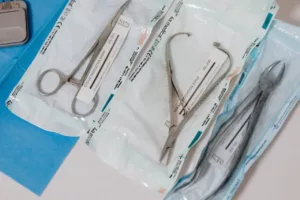We live in a throwaway culture. A culture in which takeaway cups, plastic plates, and disposable diapers are the norm. Nowhere is this single-use lifestyle more evident than in hospitals. But with mounting concerns about plastic in our oceans and landfill mountains, society is starting to push back. And this green trend is also beginning to touch the medical world — including hospitals.
Operating At Full Waste

There’s no denying hospitals are incredibly wasteful places. They use enormous amounts of energy (think lights, temperature control, a multitude of machines humming), water, and mostly, disposable supplies. This is all to combat infections and keep patients safe.
Unsurprisingly, operating rooms are the most wasteful department. But what is surprising is that OR waste includes masses of items that have been opened but never used and are simply dumped in the trash.
According to a Johns Hopkins report, U.S. hospitals collectively throw out at least $15 million a year in unused operating room surgical supplies.

Another study, by researchers at the University of California, San Francisco, found that dumping unused equipment costs almost $1,000 per procedure, stacking up to around $400,000 per surgeon, per year.
The research, which focused on neurosurgeries performed by fourteen different surgeons at UCSF Medical Center, discovered that spinal procedures are among the most wasteful.
According to the study, “surgifoam,” a special sponge used to stop bleeding costs $4,000 each, and is often just thrown away — even if it wasn’t used. This led to literally thousands upon thousands of dollars being chucked out in the trash without anyone seeming to notice.
Disposing of Medical Disposables

Aside from the environmental toll of dumping unused items, hospitals — and ultimately patients — are paying the cost, not only for throwing out unused items but also for disposing of them.
Medical waste cannot be thrown in an ordinary landfill, as there are regulations requiring hazardous waste to be disposed of separately. This can cost ten to fifteen times the cost of throwing out regular waste, which means yet more money coming from hospital budgets.
Ways to Reduce Waste In The OR
So what can surgical departments do to make the OR room more environmentally friendly?
Reuse Supplies
Just because someone overzealously opened equipment that wasn’t needed doesn’t mean it has to be thrown out (especially when it costs $4,000 a pop!). With proper care, sterilization and repackaging, it can be reused for its proper purpose rather than languishing in the landfill.

Some medical devices, even some that have been used during surgery, can be reprocessed by an FDA-approved third-party company and sold back to the hospital for about half the original sales price. That’s a win-win for both the environment and the hospital’s bottom line.
Verify What Equipment the Surgeon Needs
Check a surgeon’s preference card to establish which tools should be opened before surgery begins and which can be removed altogether could prevent unneeded or unwanted supplies from being wasted in the first place (it’s worth asking!).
Improve Planning and Communication With Equipment Reps
With better planning and communication, equipment vendors can better allocate their resources. This means if there’s a cancellation and equipment vendors receive notification in time, they can respond with enough time to prevent instruments from being opened and then wasted.
The same is true for hospital staff. If everyone is kept in the loop, they won’t open supplies for a surgery that has been canceled. So whether it’s through scheduling apps or other scheduling software — where reps are shared in on the surgical case — there are different ways to improve communication and reduce waste.
Changes In Action
As one California hospital is realizing, small changes add up. This Kaiser Permanente Sacramento Medical Center has stopped using disposable gowns, opting for washable gowns that are cleaned and — crucially — sterilized before they are reused (making those OR scrubs truly green).
They take care to recycle the packaging that instruments are packed in, re-processes tools, and even made the move to use LED lighting in the OR. The hospital estimates savings of $100,000 each year by reprocessing tools. It diverts approximately 5.6 tons of landfill as a result.
A Greener Future For Hospitals

While hospitals are never going to be operating at zero waste levels, there’s no doubt they can do much more than they are doing to improve their environmental profile.
The good news is that there are many ways to improve current processes, and every small change can make a significant difference. Performing an internal audit to find different ways to reuse supplies and equipment could ultimately have a big payoff for both the environment and the hospital’s bottom line – making the future greener for everyone.




